Turkish Section (North Wing)  The objects presented in the Turkish section come from the built up areas of the ancient delta of Po and from Adria. You will find elements from the Middle-Late Bronze Age, documenting the most ancient evidences of humane presence as well as objects indicating the arrival of foreigners in search for commercial contacts. From Contarina comes a bronze statue presenting Heracles the hunter of Etruscan, if not oriental or Greek origins. From the Greek world, not only Athenian, but also Corinthian and Ionic as well as from Etruria and southern Adriatic there are painted ceramics and object of goods exchange from the first half of the 6th century B.C.
The next exposition illustrates the characteristics of San Basilico di Ariano Polesine settlement, where, till the beginning of the 6th century B.C., there is evidence of co-existence of Veneto Etruscan and Greek groups; this location was probably used as a landing spot.
The presence of the same multi-ethnic combination is documented progressively in Adria where a new settlement is constructed. The houses with roofs made of wood and branches sealed with soil are built up on land reclamation necessary to guarantee dry environment - as presented on the plastic model.
Imported objects like the ceramics and architectural decorations as well as Greek and Etruscan inscriptions, give us the opportunity to follow the active life of the city, which above all was a port.
Further down, divided according to various themes, there are displays dedicated to a vast collection of Attic red and black figure ceramics. The vases, unfortunately in pieces, are grouped not only according to their decoration but the technique they were made in: on the right there are mostly cabinets that illustrate the technique and various forms, on the left those dedicated to iconography: the female and male worlds, the symposium, the myth, the heroes and divinity, among others Heracles and Dionysus, etc.
Although the exhibits are generally in pieces, they most often represent the work of famous Athenian painters that used to decorate prestigious, most refined vases. The objects presented in the Turkish section come from the built up areas of the ancient delta of Po and from Adria. You will find elements from the Middle-Late Bronze Age, documenting the most ancient evidences of humane presence as well as objects indicating the arrival of foreigners in search for commercial contacts. From Contarina comes a bronze statue presenting Heracles the hunter of Etruscan, if not oriental or Greek origins. From the Greek world, not only Athenian, but also Corinthian and Ionic as well as from Etruria and southern Adriatic there are painted ceramics and object of goods exchange from the first half of the 6th century B.C.
The next exposition illustrates the characteristics of San Basilico di Ariano Polesine settlement, where, till the beginning of the 6th century B.C., there is evidence of co-existence of Veneto Etruscan and Greek groups; this location was probably used as a landing spot.
The presence of the same multi-ethnic combination is documented progressively in Adria where a new settlement is constructed. The houses with roofs made of wood and branches sealed with soil are built up on land reclamation necessary to guarantee dry environment - as presented on the plastic model.
Imported objects like the ceramics and architectural decorations as well as Greek and Etruscan inscriptions, give us the opportunity to follow the active life of the city, which above all was a port.
Further down, divided according to various themes, there are displays dedicated to a vast collection of Attic red and black figure ceramics. The vases, unfortunately in pieces, are grouped not only according to their decoration but the technique they were made in: on the right there are mostly cabinets that illustrate the technique and various forms, on the left those dedicated to iconography: the female and male worlds, the symposium, the myth, the heroes and divinity, among others Heracles and Dionysus, etc.
Although the exhibits are generally in pieces, they most often represent the work of famous Athenian painters that used to decorate prestigious, most refined vases. |
Blue Night Section (East Wing) 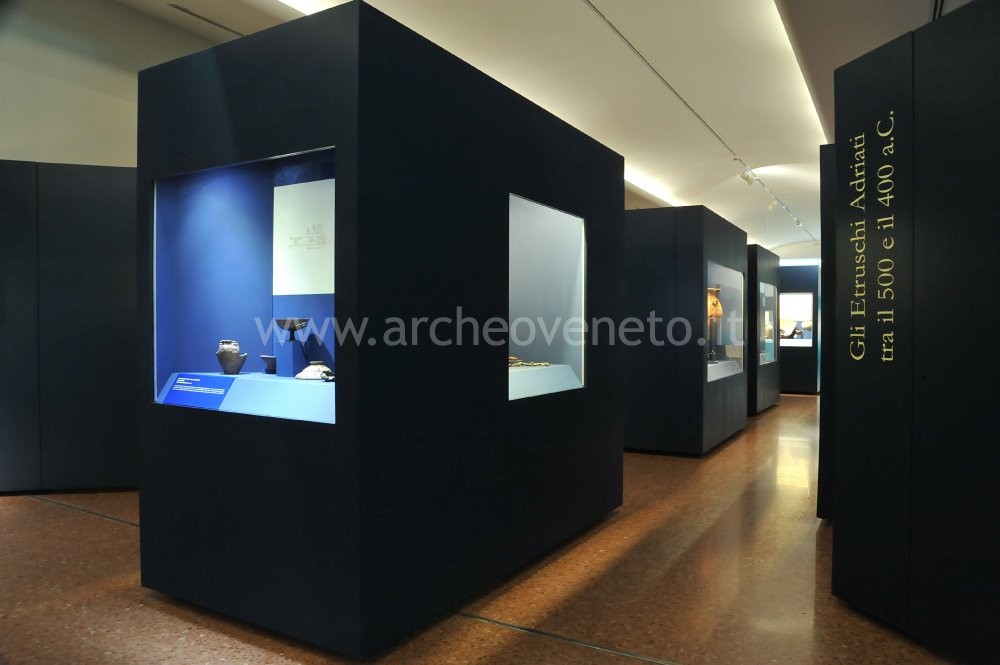 This section presents the most important grave goods from the Archaic and Classic era (between the 6th and 5th century B.C.), from which the whole burial ritual, including the entombment and cremation, can be reconstructed.
All grave goods have very different origins visible in the material used and the purpose of the items: from Veneto influence represented by jars and bowls in local ceramics, through Greek and Mediterranean trends visible both in the banquet pieces made of imported ceramics as well as in the wealth of the polychrome glass balm containers, to Etruscan influence, most evident in the presence of bronze and iron objects used for prestigious table-wear and wine serving, for cooking and meat consumption. Men’s grave goods can easily be distinguished, the pieces for banquet celebration are rich, there are knife sets, andirons and iron skewers, jugs and bronze containers. Female grave goods are more modest, high status of the deceased is confirmed by the presence of precious perfume containers and jewellery. More modest grave goods from the 4th century B.C. may suggest a crisis period in the economy of the city. This section presents the most important grave goods from the Archaic and Classic era (between the 6th and 5th century B.C.), from which the whole burial ritual, including the entombment and cremation, can be reconstructed.
All grave goods have very different origins visible in the material used and the purpose of the items: from Veneto influence represented by jars and bowls in local ceramics, through Greek and Mediterranean trends visible both in the banquet pieces made of imported ceramics as well as in the wealth of the polychrome glass balm containers, to Etruscan influence, most evident in the presence of bronze and iron objects used for prestigious table-wear and wine serving, for cooking and meat consumption. Men’s grave goods can easily be distinguished, the pieces for banquet celebration are rich, there are knife sets, andirons and iron skewers, jugs and bronze containers. Female grave goods are more modest, high status of the deceased is confirmed by the presence of precious perfume containers and jewellery. More modest grave goods from the 4th century B.C. may suggest a crisis period in the economy of the city. |
Turkish Section (South-East Corner) 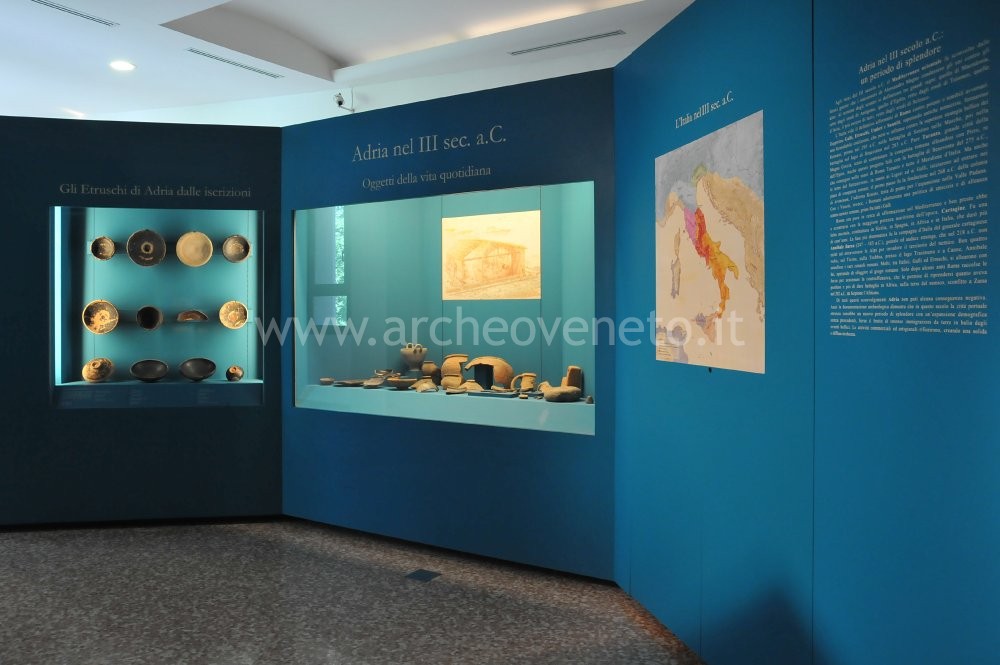 In the 3rd century B.C. the city lives through a period of a new economic splendour which results in the presence of new and different imported materials originating from the Etruscan and Adriatic areas as well as some showing Celtic influence.
This section also hosts main exhibits documenting everyday life. There is quite a variety of ceramics from those painted entirely in black, with rich sculptured decorations, some of them made in Volterra, through those more typical of Adriatic markets, with rough geometric or symbolic decorations all the way to those typical of Puglia, with their white and yellow decorations, often with plant motives. The more ‘industrial’, ‘mass production’ items in grey ceramics are becoming more popular. The inscriptions from this period leave us the names of the Etruscans that inhabited the city. In the 3rd century B.C. the city lives through a period of a new economic splendour which results in the presence of new and different imported materials originating from the Etruscan and Adriatic areas as well as some showing Celtic influence.
This section also hosts main exhibits documenting everyday life. There is quite a variety of ceramics from those painted entirely in black, with rich sculptured decorations, some of them made in Volterra, through those more typical of Adriatic markets, with rough geometric or symbolic decorations all the way to those typical of Puglia, with their white and yellow decorations, often with plant motives. The more ‘industrial’, ‘mass production’ items in grey ceramics are becoming more popular. The inscriptions from this period leave us the names of the Etruscans that inhabited the city. |
Dark Green Section (South Wing and Balcony) 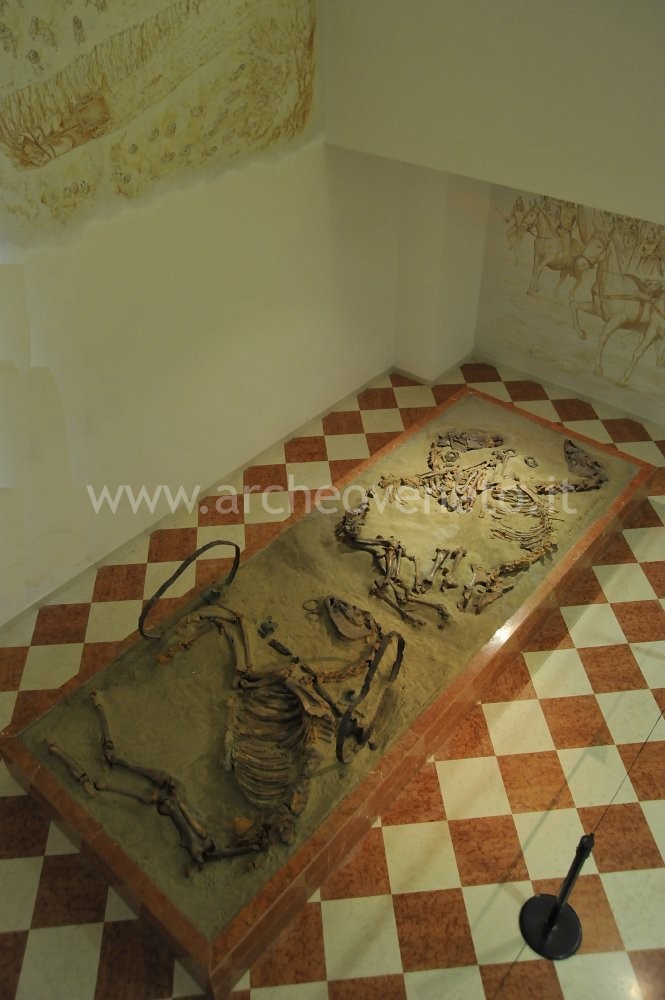 From the balcony, which can be accessed from the Southeast corner, there is a view on the ‘Chariot tomb’, one of the most famous Adria graves. It is a tomb in which a two-wheel cart is buried together with its three horses, two at the front and the third at the back (probably the riding horse that was tied up behind the cart). Although we can not be sure whom such magnificent grave goods could belong to, thanks to well preserved rich harness we can date this grave back to the first half of the 3rd century B.C. From approximately the same period are all the graves located along the corridor leading to the south wing and towards the stairs to the next floor down.
In this exceptionally prosperous period of time grave goods become particularly magnificent; by this time the ritual of cremation is almost completely replaced by the ‘traditional’ burial. For as much as the banquet elements for meat consumption found in men’s graves become less impressive compared to the previous period, the situation is different with the female grave goods. They are rich and contain bras jewels. A large number of pottery items suggest a collective participation in funeral services.
A whole display cabinet located about half way down the route is dedicated just to the jewellery. There you can admire Etruscan goldsmith art, characterised by rich decoration and executed with the granulation technique as well as the splendour of adornment pieces in silver, glass cameos and amber. Among the feminine graves there is one piece, found in the head area of the grave, that truly stands out: a headdress made of a group of silver rings. From the balcony, which can be accessed from the Southeast corner, there is a view on the ‘Chariot tomb’, one of the most famous Adria graves. It is a tomb in which a two-wheel cart is buried together with its three horses, two at the front and the third at the back (probably the riding horse that was tied up behind the cart). Although we can not be sure whom such magnificent grave goods could belong to, thanks to well preserved rich harness we can date this grave back to the first half of the 3rd century B.C. From approximately the same period are all the graves located along the corridor leading to the south wing and towards the stairs to the next floor down.
In this exceptionally prosperous period of time grave goods become particularly magnificent; by this time the ritual of cremation is almost completely replaced by the ‘traditional’ burial. For as much as the banquet elements for meat consumption found in men’s graves become less impressive compared to the previous period, the situation is different with the female grave goods. They are rich and contain bras jewels. A large number of pottery items suggest a collective participation in funeral services.
A whole display cabinet located about half way down the route is dedicated just to the jewellery. There you can admire Etruscan goldsmith art, characterised by rich decoration and executed with the granulation technique as well as the splendour of adornment pieces in silver, glass cameos and amber. Among the feminine graves there is one piece, found in the head area of the grave, that truly stands out: a headdress made of a group of silver rings. |
Orange Section (Mezzanine, South Wing) 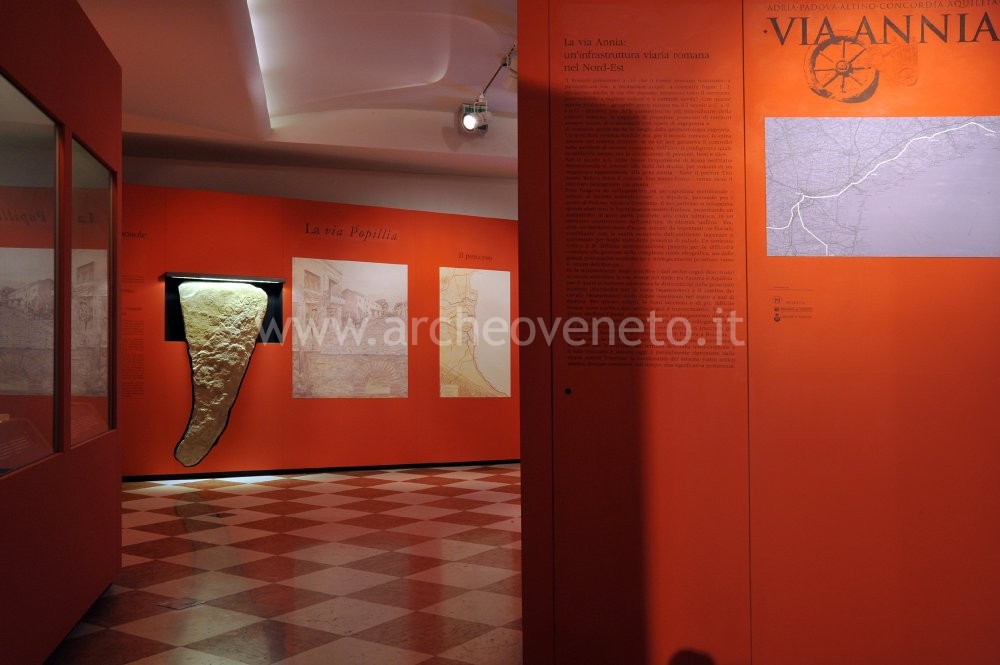 Going down the stairs that lead to the mezzanine you will be accompanied by an exhibition of amphoras that document the passage to the Romanization era, a moment in which the Roman inhabitants start to add to the complexity of the already multi-ethnic city.
The Romans who arrive in Adria will confront the last inhabitants still connected to the Etruscan world and its customs. Their burial places are exhibited on the left of the room. The grave goods still present a degree of wealth and demonstrate various influences and import liveliness.
A clay female head carrying a veil and a terracotta statue of a woman both used to decorate the fronts of the buildings suggest the existence of a more developed architectural structure of Adria, Aquileia and probably other ancient Veneto cities. This turning point in urban architecture is a result of contacts with the Roman-Italic world and is favoured by drafting of an effective road network that starts to flourish in the Veneto region during the second half of the 2nd century B.C.
In Adria there are two main directories that connect the Etruscan/Padana/costal area with Veneto and the north: 1/via Popillia, initiated with a milestone placed by consul Popillio Lenate and discovered in the city around the Tomb church, with the stone still in its original position and 2/via Annia, which linked the city with Padova and therefore with Altino, Concordia and Aquileia; there is a separate multimedia point dedicated to this street.
From the north-west angle of the room you can access the ‘Chariot tomb’ room where you can get a close-up view of the tomb. Further down there are first burial places from the 2nd and 1st century B.C. They clearly demonstrate the change in funeral customs due to the Romans arrival. The actual burial rite is abandoned in favour of the cremation. The graves contents still confirm the existence of commercial contacts with other parts of the world (e.g. the glass cup of oriental origins, from the region of Syria/Palestine and the terracotta jug with a negroid head).
There are first examples of numismatics indicating the beginning of the Imperial Era in the city. Going down the stairs that lead to the mezzanine you will be accompanied by an exhibition of amphoras that document the passage to the Romanization era, a moment in which the Roman inhabitants start to add to the complexity of the already multi-ethnic city.
The Romans who arrive in Adria will confront the last inhabitants still connected to the Etruscan world and its customs. Their burial places are exhibited on the left of the room. The grave goods still present a degree of wealth and demonstrate various influences and import liveliness.
A clay female head carrying a veil and a terracotta statue of a woman both used to decorate the fronts of the buildings suggest the existence of a more developed architectural structure of Adria, Aquileia and probably other ancient Veneto cities. This turning point in urban architecture is a result of contacts with the Roman-Italic world and is favoured by drafting of an effective road network that starts to flourish in the Veneto region during the second half of the 2nd century B.C.
In Adria there are two main directories that connect the Etruscan/Padana/costal area with Veneto and the north: 1/via Popillia, initiated with a milestone placed by consul Popillio Lenate and discovered in the city around the Tomb church, with the stone still in its original position and 2/via Annia, which linked the city with Padova and therefore with Altino, Concordia and Aquileia; there is a separate multimedia point dedicated to this street.
From the north-west angle of the room you can access the ‘Chariot tomb’ room where you can get a close-up view of the tomb. Further down there are first burial places from the 2nd and 1st century B.C. They clearly demonstrate the change in funeral customs due to the Romans arrival. The actual burial rite is abandoned in favour of the cremation. The graves contents still confirm the existence of commercial contacts with other parts of the world (e.g. the glass cup of oriental origins, from the region of Syria/Palestine and the terracotta jug with a negroid head).
There are first examples of numismatics indicating the beginning of the Imperial Era in the city. |
Red Section (Mezzanine, East Wing) 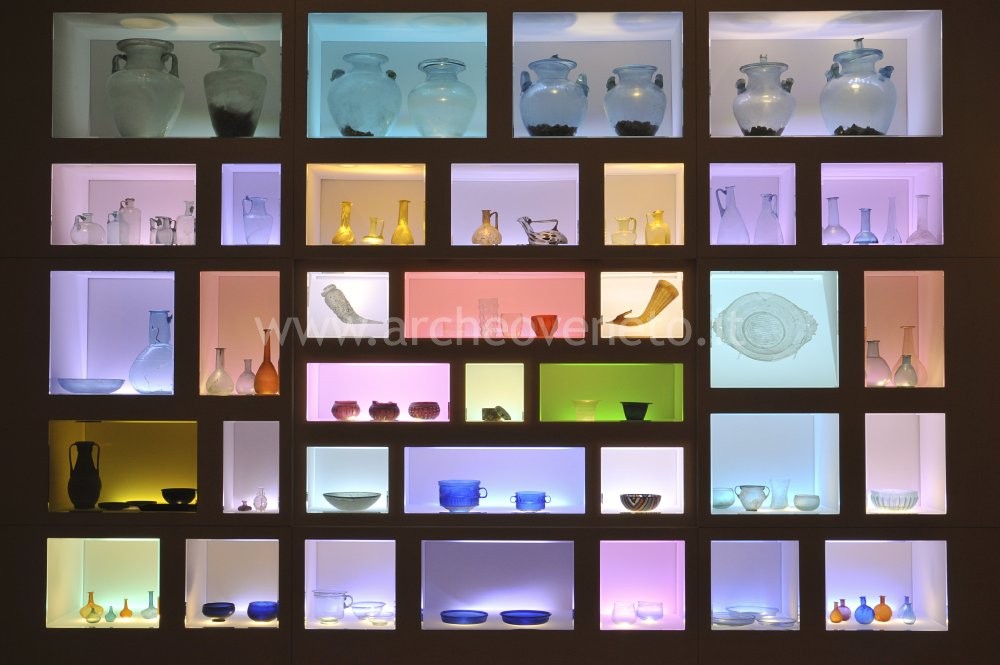 In this section we tried to reconstruct the monumentality of the Roman city in the Imperial Age (1st-2nd century A.D.). Unfortunately there are very few exhibits that have survived till today. The architectural layout of the city has been partly reconstructed thanks to the objects that used to be subject of trade activities (amphoras, artefacts in bronze and terracotta and coins), partly based on very few items found underground and finally based on extensive archive documentation left by Francesco Antonio Bocchi. A wide variety of marble found in the city is the confirmation of the city’s still very active contacts with the Mediterranean world. The multitude of the origins is demonstrated on the map provided.
Everyday live is illustrated in the display dedicated to table wear ceramics and in a series of small displays presenting bathroom and adornment objects.
An impressive display presents a large collection of Adria’s glass objects, some very refine, varying in form and technique of production. The collection is divided into objects from residential and necropolis areas. In this section we tried to reconstruct the monumentality of the Roman city in the Imperial Age (1st-2nd century A.D.). Unfortunately there are very few exhibits that have survived till today. The architectural layout of the city has been partly reconstructed thanks to the objects that used to be subject of trade activities (amphoras, artefacts in bronze and terracotta and coins), partly based on very few items found underground and finally based on extensive archive documentation left by Francesco Antonio Bocchi. A wide variety of marble found in the city is the confirmation of the city’s still very active contacts with the Mediterranean world. The multitude of the origins is demonstrated on the map provided.
Everyday live is illustrated in the display dedicated to table wear ceramics and in a series of small displays presenting bathroom and adornment objects.
An impressive display presents a large collection of Adria’s glass objects, some very refine, varying in form and technique of production. The collection is divided into objects from residential and necropolis areas. |
Aquamarine Section (Mezzanine, North East Corner) 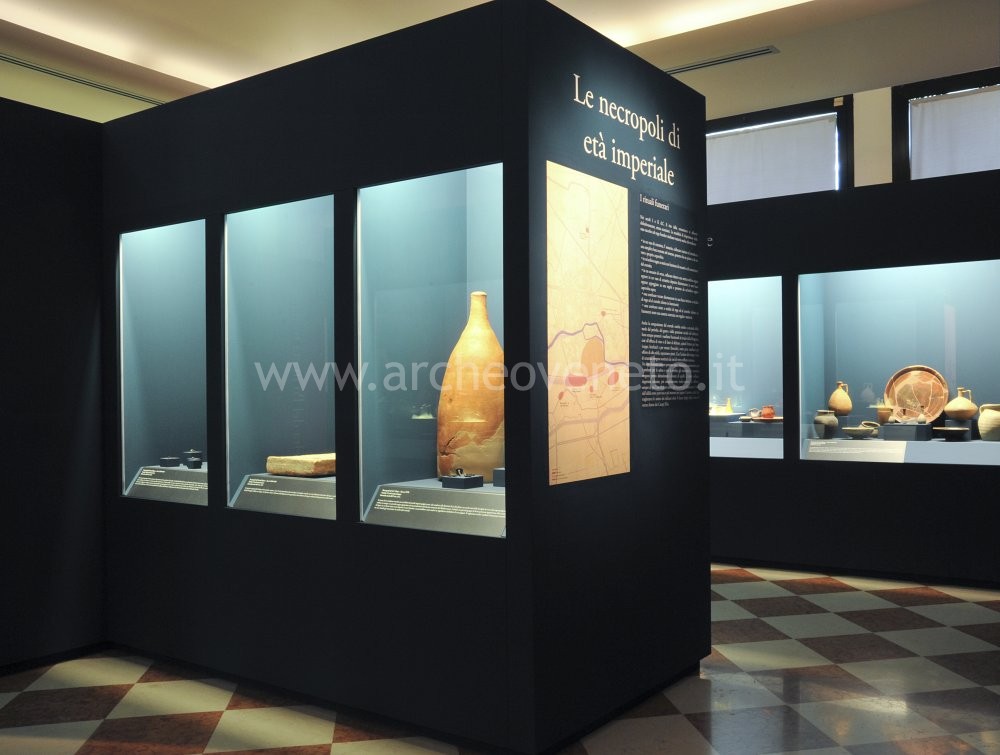 In this section some of the graves from the 1st century A.D. are presented, with the bodies that have all undergone the process of cremation. The grave goods are not as impressive as those from the Etruscan Era, still quite often contain precious glass objects of exceptional quality both in form and colour. The coffins are very simple and modest but and the grave goods are usually protected by ceramic tiles and parts of amphoras. Also the simplicity of the funeral monuments presented in the lapidary is in line with the tone of the rest of the exhibits. In this section some of the graves from the 1st century A.D. are presented, with the bodies that have all undergone the process of cremation. The grave goods are not as impressive as those from the Etruscan Era, still quite often contain precious glass objects of exceptional quality both in form and colour. The coffins are very simple and modest but and the grave goods are usually protected by ceramic tiles and parts of amphoras. Also the simplicity of the funeral monuments presented in the lapidary is in line with the tone of the rest of the exhibits. |
Lapidary (Mezzanine, Cloister) 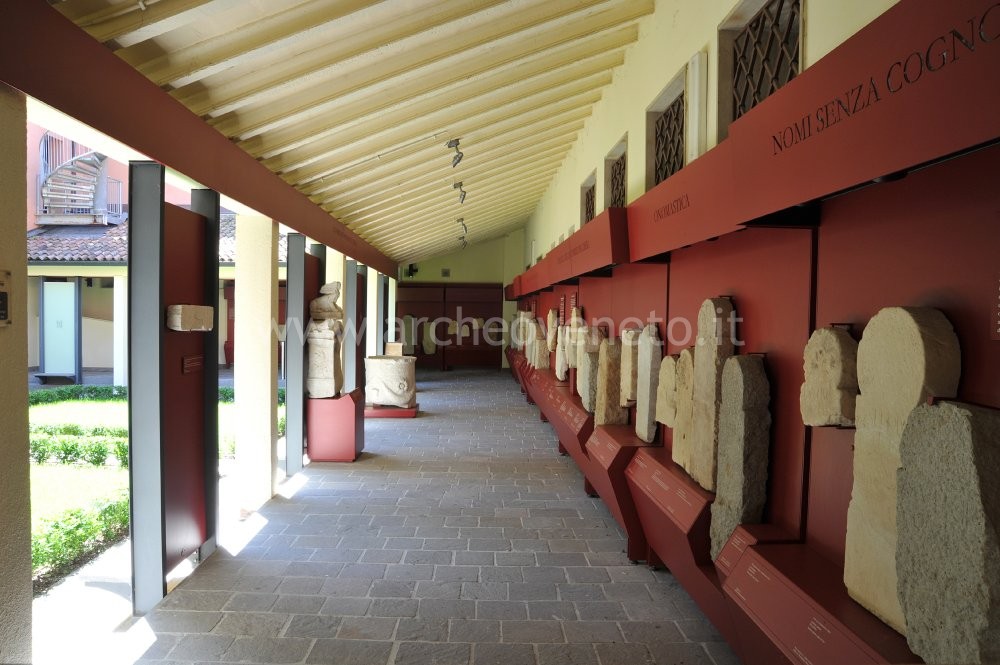 In this section some stone exhibits from the 1st century B.C. through to 1st century A.D. are presented. There are some examples of cult stones, but most of them are funeral monuments that through inscriptions document social and civil organisation of a Roman city. Along the east side there are inscriptions that document the epigraphic techniques and some inscriptions related to cults and public duties of the city. Along the north side you can find the only insular marble sarcophagus discovered in Adria, dedicated to Terentia Capitolina, and some examples of funeral monuments.
Along the west and south sides there is a series of inscriptions grouped according to the social classes represented in the city (as interpreted from the onomastics).
The inscriptions dedicated to free men and women placed side by side by with those dedicated to freedmen clearly demonstrate the social ‘tolerance’ of the Roman world. There are even some examples of funeral inscriptions dedicated from masters to their slaves and demonstrating, in some cases, the existence of a relationship strong enough to override that of the ownership. In this section some stone exhibits from the 1st century B.C. through to 1st century A.D. are presented. There are some examples of cult stones, but most of them are funeral monuments that through inscriptions document social and civil organisation of a Roman city. Along the east side there are inscriptions that document the epigraphic techniques and some inscriptions related to cults and public duties of the city. Along the north side you can find the only insular marble sarcophagus discovered in Adria, dedicated to Terentia Capitolina, and some examples of funeral monuments.
Along the west and south sides there is a series of inscriptions grouped according to the social classes represented in the city (as interpreted from the onomastics).
The inscriptions dedicated to free men and women placed side by side by with those dedicated to freedmen clearly demonstrate the social ‘tolerance’ of the Roman world. There are even some examples of funeral inscriptions dedicated from masters to their slaves and demonstrating, in some cases, the existence of a relationship strong enough to override that of the ownership. |
Red Section (Mezzanine, North Wing) 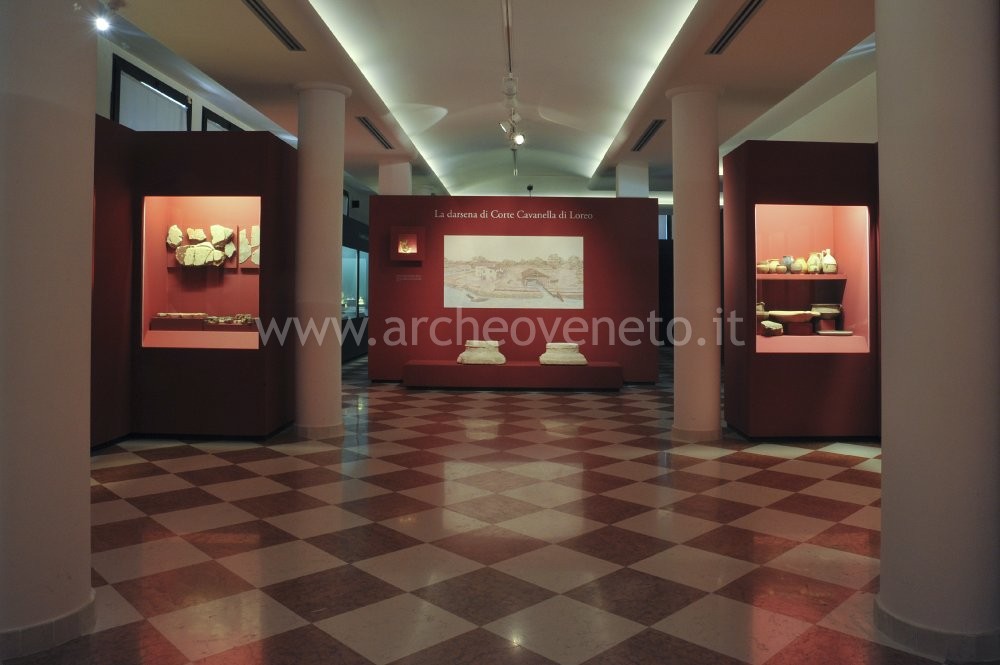 The last section, dedicated to the inhabited areas of the city, illustrates two important territories of Po’s delta, which have been the source of significant historic evidence from the period between Imperial and Late Antique Era. We are talking about the discoveries in Loreo, Corte Cavanella and in San Basilio di Ariano Polesine. In Corte Cavanella the excavations lead to the discovery of a harbour related structure located in a branch of Adige. It has been identified as mansio Fossis, one of the ‘staging posts’ of the Imperial Era. The structural remains are partly reconstructed and accompanied by a rich selection of exhibits, among others an oscilla, theatrical mask in terracotta and a marble table dedicated to the Oriental cult of Mitra god.
In San Basilio the remains of a rustic villa allowed the identification of a settlement around the crossing of the coastal via Popillia and a staging post, mansio Hadriani. During the 1st century A.D. the road tracks started to follow the water tracks, so-called fossae, in particular fossa Clodia e la fossa Neroniana. That allowed for coastal navigation on a small scale.
Also in San Basilico there are evidences of some precocious Christianisation objects (lamps) and structures (a complex that includes a octagonal baptistery, still visible in the archaeological area). The last section, dedicated to the inhabited areas of the city, illustrates two important territories of Po’s delta, which have been the source of significant historic evidence from the period between Imperial and Late Antique Era. We are talking about the discoveries in Loreo, Corte Cavanella and in San Basilio di Ariano Polesine. In Corte Cavanella the excavations lead to the discovery of a harbour related structure located in a branch of Adige. It has been identified as mansio Fossis, one of the ‘staging posts’ of the Imperial Era. The structural remains are partly reconstructed and accompanied by a rich selection of exhibits, among others an oscilla, theatrical mask in terracotta and a marble table dedicated to the Oriental cult of Mitra god.
In San Basilio the remains of a rustic villa allowed the identification of a settlement around the crossing of the coastal via Popillia and a staging post, mansio Hadriani. During the 1st century A.D. the road tracks started to follow the water tracks, so-called fossae, in particular fossa Clodia e la fossa Neroniana. That allowed for coastal navigation on a small scale.
Also in San Basilico there are evidences of some precocious Christianisation objects (lamps) and structures (a complex that includes a octagonal baptistery, still visible in the archaeological area). |
Purple Section (Mezzanine, North Wing) 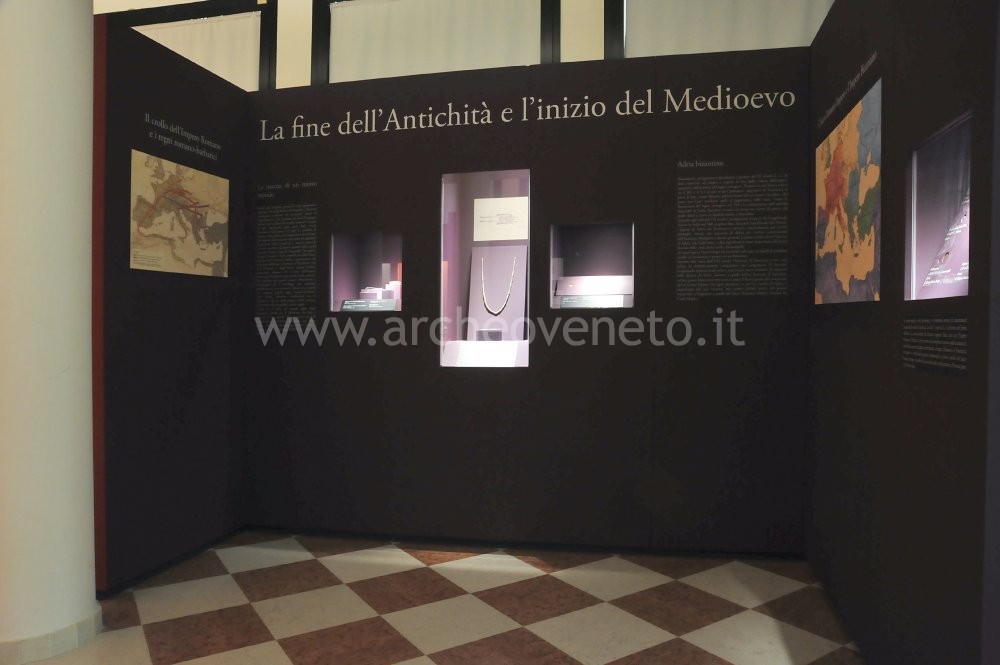 This room holds the scarce evidence from the city’s survival in the Late Antique and Byzantine Era. It is that traumatic period in time that the following items come from: female grave goods from the 7th century A.D. with some rich jewellery and a series of coins, among others some of Arabic origins. The latter confirm the unstoppable urge to maintain contacts with the Mediterranean world. This room holds the scarce evidence from the city’s survival in the Late Antique and Byzantine Era. It is that traumatic period in time that the following items come from: female grave goods from the 7th century A.D. with some rich jewellery and a series of coins, among others some of Arabic origins. The latter confirm the unstoppable urge to maintain contacts with the Mediterranean world. |
Grey Section (Mezzanine, North Wing) 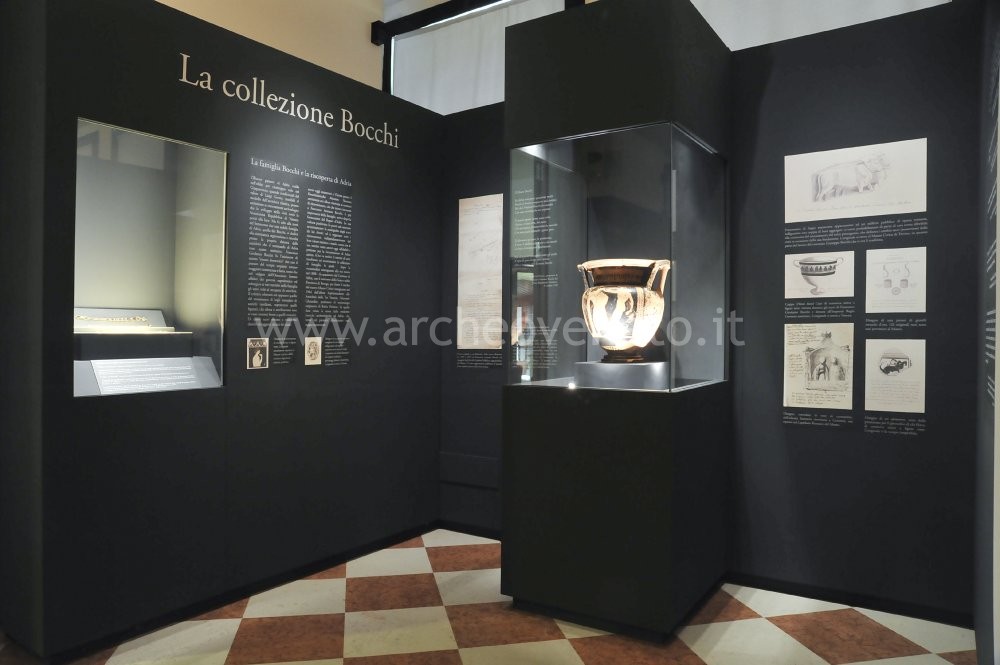 This small section at the end of the tour is dedicated to the memory of the work carried out by the Bocchi family who set up solid base for the preservation and protection of the archaeological legacy of the city. We have briefly drafted out the story of the collection that was the starting point for the Museum first opened by Gherardo Ghiradini as Civil Museum back in 1904. Here you will find a vase decorated with red figures discovered in Amolara region and some jewels from the first half of the 19th century with modern precious stones assembled into necklaces and bracelets. This small section at the end of the tour is dedicated to the memory of the work carried out by the Bocchi family who set up solid base for the preservation and protection of the archaeological legacy of the city. We have briefly drafted out the story of the collection that was the starting point for the Museum first opened by Gherardo Ghiradini as Civil Museum back in 1904. Here you will find a vase decorated with red figures discovered in Amolara region and some jewels from the first half of the 19th century with modern precious stones assembled into necklaces and bracelets. |
| Schöne R. 1878, Le antichità del Museo Bocchi di Adria, Roma. |
| Riccioni G. 1957, Adria I, in Corpus Vasorum Antiquorum, Roma. |
| Bermond Montanari G. 1964, Ceramica attica a figure nere del Museo Archeologico di Adria, in Bollettino d’Arte, XLIX, pp. 289. |
| Il Museo Archeologico di Adria 1964, a cura di Scarfi B.M. , Padova. |
| 1961-1986: Il Museo Archeologico Nazionale di Adria a venticinque anni dalla fondazione 1986, a cura di Sanesi Mastrocinque L., Taglio di Po. |
| Il Museo Archeologico Nazionale di Adria 1988, a cura di De Min M. , Padova . |
| Bonomi S. 1993, Gli scavi di Francesco Antonio Bocchi nell'abitato di Adria, in Francesco Antonio Bocchi e il suo tempo. 1821-1888, Atti del 16 Congresso di Studi storici (Adria, 21-22 aprile 1990), Rovigo, pp. 75-85. |
| Bonomi S. 1996, Vetri antichi del Museo archeologico nazionale di Adria, Venezia. |
| Guida per la visita del Museo Archeologico Nazionale di Adria 1996, a cura di Rotary Club di Adria, Adria. |
| Bonomi S. 2003, Rovigo e il Polesine. Adrias, Atria, in Luoghi e tradizioni d'Italia. Veneto, II, Roma. |
| Musei e raccolte archeologiche del Veneto 2004, a cura di Di Mauro A., Dosson di Casier, pp. 71-72. |
| Wiel Marin F. 2005, La ceramica attica a figure rosse di Adria. La famiglia Bocchi e l'archeologia, Padova. |
| Le pietre parlano: il lapidario romano di Adria 2006, a cura di Bonomi S., Sigolo R., Zega L. , Adria. |
| La sezione etrusca: Adria e il Basso Polesine tra i secoli VI e III a.C. 2008, a cura di Bonomi S., Zega L., Adria. |
| Bonetto J. 2009, Veneto (Archeologia delle Regioni d'Italia), Roma, pp. 382-386. |
| L'età romana e l'alto Medioevo. Adria e il Basso Polesine tra i secoli II a.C. e IX d.C. 2010, a cura di Bonomi S., Zega L., Padova. |
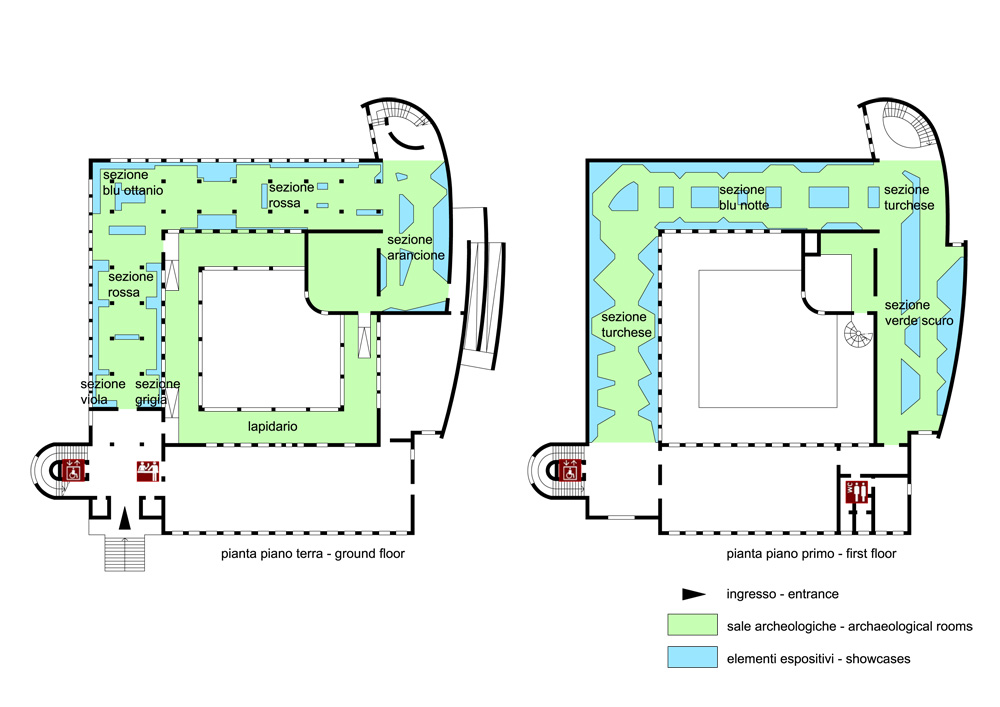
 School access
School access
 Disabled access
Ramp and lift to the first floor
Disabled access
Ramp and lift to the first floor
 Toilet
Toilet Parking
Parking Guide a stampa
Guide a stampa Information boards
Information boards Captions under exhibits
Captions under exhibits PC learning points
PC learning points Guided Tours
Guided Tours  Educational activities
Educational activities Educational workshops
Educational workshops Library and documentation centre
Library and documentation centre Other activities
Other activities